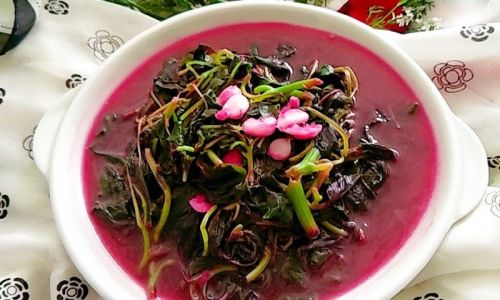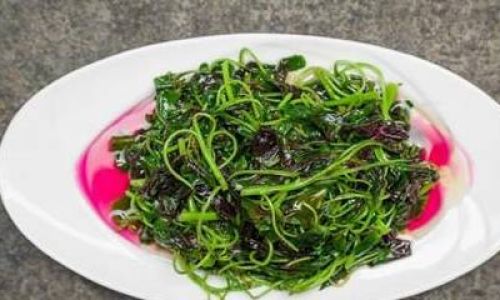Introduction
Stir-fried amaranth leaves, a vibrant and nutritious dish hailing from various cuisines across Asia, particularly those in China and Southeast Asia, offer a delightful blend of flavors and textures. Amaranth, scientifically known as Amaranthus tricolor, is a leafy vegetable rich in vitamins, minerals, and antioxidants. Its succulent leaves, adorned with hues of red, green, and purple, not only enhance the visual appeal of any meal but also contribute to its nutritional profile. This guide aims to provide a comprehensive understanding of how to cook stir-fried amaranth leaves, from selecting the freshest ingredients to mastering the stir-fry technique, ensuring a delicious and satisfying dish every time.
Section 1: Selecting and Preparing the Amaranth Leaves

1 Choosing Fresh Amaranth Leaves
The first step in preparing stir-fried amaranth leaves is selecting the freshest produce. Look for leaves that are vibrant in color, with no signs of wilting or yellowing. The stems should be firm and crisp, indicating freshness. Avoid leaves with spots, bruises, or an unpleasant odor, as these are signs of spoilage. When possible, opt for locally grown amaranth as it is likely to be fresher and more flavorful.
2 Washing and Draining
Once you’ve selected your amaranth leaves, it’s crucial to wash them thoroughly to remove any dirt, pesticides, or other contaminants. Fill a large bowl with cold water and submerge the leaves, gently swirling them around to loosen any debris. Repeat this process two to three times, or until the water runs clear. Use a salad spinner or a clean kitchen towel to drain the leaves thoroughly, removing as much excess water as possible. Excess moisture can cause the stir-fry to steam rather than sear, resulting in a less crispy texture.
3 Preparing the Leaves
To prepare the amaranth leaves for stir-frying, you’ll need to pluck the leaves from their stems. While the stems are edible, they tend to be tougher and require longer cooking times, which can overcook the delicate leaves. Discard any thick or woody stems and cut the remaining stems into bite-sized pieces if you prefer to include them. Stack the leaves in small batches and slice them into thin strips or chiffonade them for a more elegant presentation. This not only makes the leaves easier to eat but also ensures they cook evenly.
Section 2: Gathering Your Ingredients and Tools
1 Essential Ingredients
Beyond the fresh amaranth leaves, there are a few staple ingredients you’ll need to create a flavorful stir-fry:
- Garlic: Minced garlic adds a savory aroma and depth of flavor.
- Ginger: Finely sliced or grated ginger provides a subtle heat and freshness.
- Vegetable Oil: A neutral oil like canola or grapeseed is ideal for stir-frying, as it has a high smoking point and neutral taste.
- Salt and Pepper: To season the dish.
- Oyster Sauce (optional): Adds a rich, savory umami flavor.
- Sesame Oil (optional): A drizzle at the end enhances the dish’s aroma and taste.
2 Tools and Equipment
- Wok or Large Frying Pan: A wok is traditional for stir-frying due to its shape, which allows for even heat distribution and easy tossing of ingredients. However, a large, heavy-bottomed frying pan works well too.
- Spatula or Wooden Spoon: A spatula with a flat edge is perfect for tossing ingredients in the wok or pan without breaking them.
- Chef’s Knife: For slicing the garlic, ginger, and preparing the amaranth leaves.
- Measuring Spoons: For adding precise amounts of seasoning.
- Colander or Salad Spinner: For washing and draining the leaves.
Section 3: Mastering the Stir-Fry Technique
1 Preheating the Pan
Before adding any ingredients, preheat your wok or frying pan over medium-high heat until it’s very hot. This ensures that the oil reaches the right temperature quickly, creating a sear on the vegetables that locks in flavor and moisture.
2 Adding Oil and Aromatics
Once the pan is hot, pour in a tablespoon of vegetable oil and swirl it around to coat the bottom evenly. Add the minced garlic and grated ginger, stirring constantly to prevent them from burning. The aromatics should sizzle and become fragrant within 30 seconds to a minute.

3 Stir-Frying the Amaranth Leaves
Immediately after the aromatics are fragrant, add the prepared amaranth leaves to the pan in a single layer, if possible. This allows for even cooking. If your pan is small, you may need to stir-fry in batches to avoid overcrowding. Stir-fry the leaves vigorously using a spatula or wooden spoon, tossing them continuously to ensure they cook evenly. The leaves should wilt and turn a brighter green (or retain their original vibrant colors) within two to three minutes.
4 Seasoning and Finishing
As soon as the leaves are tender but still slightly crisp, season with salt and pepper to taste. If using, add a teaspoon of oyster sauce and stir well to combine. The heat of the pan will warm the sauce and coat the leaves evenly. Taste and adjust the seasoning as needed.
5 Adding a Final Touch
Before removing the stir-fry from the heat, drizzle a teaspoon of sesame oil over the top. The sesame oil’s nutty aroma and flavor will elevate the dish without overpowering the delicate taste of the amaranth leaves.
Section 4: Serving and Enjoying Your Stir-Fried Amaranth Leaves
1 Serving Suggestions
Stir-fried amaranth leaves can be served as a side dish or incorporated into a larger meal. They pair well with rice, noodles, or tofu for a complete and balanced meal. For added protein, consider topping the stir-fry with scrambled eggs, grilled chicken, or shrimp.
2 Storage and Reheating
Leftover stir-fried amaranth leaves can be stored in an airtight container in the refrigerator for up to two days. To reheat, place them in a microwave-safe dish and cover with a damp paper towel to retain moisture. Heat on medium power until warm, stirring occasionally to prevent overcooking. Alternatively, you can reheat them on the stovetop over low heat, stirring frequently.
Conclusion
Stir-fried amaranth leaves are a simple yet elegant dish that can elevate any meal. By following the steps outlined in this guide, from selecting the freshest ingredients to mastering the stir-fry technique, you’ll be able to create a vibrant, nutritious, and flavorful dish that’s sure to impress. Whether you’re serving it as a side or incorporating it into a larger meal, stir-fried amaranth leaves offer a delightful combination of taste, texture, and nutrition that’s perfect for any occasion. Happy cooking!






0 comments